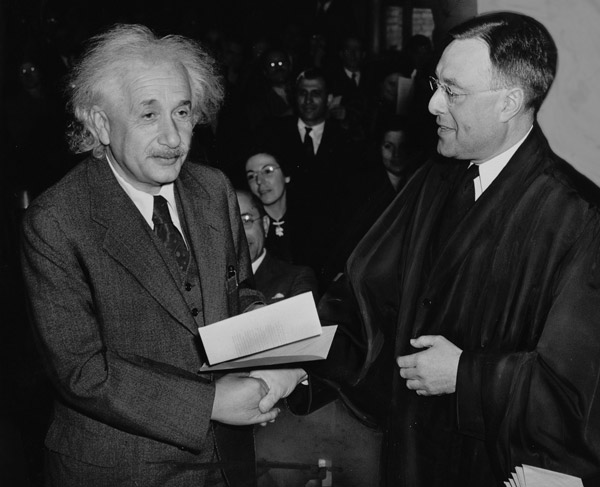The United Nations has designated January 27 as International Holocaust Remembrance Day. Countries around the world remember and honor the victims of the Nazi genocide. The Nazis murdered six million Jews in the Holocaust, and tens of thousands of Roma and Sinti, Jehovah’s Witnesses, and the mentally and physically disabled, homosexuals, political prisoners, and others. For more information on the Holocaust, visit the United States Holocaust Memorial Museum in Washington, DC or online.
Beginning in the 1930s, Adolf Hitler and the Nazis actively persecuted Jews, those of part-Jewish descent, and political opponents, including those in prominent academic positions. As a result, many leading scientists, philosophers, and thinkers fled to the West. Many refugees later joined the Manhattan Project in England and America.
Among the scientists who fled Europe were Albert Einstein, Hans Bethe, John von Neumann, Leo Szilard, James Franck, Edward Teller, Rudolf Peierls, and Klaus Fuchs. Enrico Fermi‘s wife Laura was Jewish; after the 1938 Nobel Prize ceremony, he and his family left for the United States. Joseph Rotblat returned home to Poland and left days before the outbreak of World War II. Tragically, his wife was unable to accompany him and later died during the Holocaust in a concentration camp. Stanislaw Ulam fled Poland with his brother Adam shortly before the German invasion in September 1939. The rest of Ulam’s family, including his parents and sister, were killed in the Holocaust.
Rose Bethe, the widow of Nobel Prize-winning physicist Hans Bethe, grew up in Germany as the Nazis were coming to power. She remembers, “I was in my fifth year in the Gymnasium in high school when Hitler came to power. We returned from that vacation and I found a noticeable change in the atmosphere of my school, in the way various classes were being taught. In Germany, all children have to take religious instruction in school. I was in the General Lutheran instruction group and instead of having the philosophy professor from the boys high school, we suddenly had somebody else. He turned out to be a Nazi and his main aim was to tell us that the Jews were Jews and they had killed Christ and they were awful people. That was essentially his message…I just wouldn’t have it; I dropped out of school two years before I should have and I managed to get to England.”
Lilli Hornig was born in the Czech Republic and moved to Berlin with her family when she was eight. “We lived there for four years. After Hitler came to power, my father was actually being threatened with being taken off to a concentration camp. And he spent several weeks sleeping at friends’ houses so he wouldn’t be found, and he left for America. My mother and I had to wait for quite a long time, well, several months, to follow him.”
Dieter Gruen grew up in Waldorf, Germany. “I was no longer able to go to school because the Hitlerjugend would beat me up after school,” he remembers. “It became clear that if I wanted to survive, I would have to leave.” Gruen was able to emigrate to the United States and ultimately reunited with his parents in Chicago.
One of the ironies of Hitler’s desire for racial purity was that it drove out of continental Europe or into the camps many individuals who would have been extremely useful to the Axis war effort. Nowhere was this more evident than in the effort to produce an atomic bomb. A startling proportion of the most famous names on the project belonged to scientists who came to England or America to flee from the Axis. The large number of refugees and immigrants working on the Manhattan Project gave the American nuclear program an international character unusual in such a top-secret program—and unique amongst the nuclear programs that followed in other countries—and helped give life in Los Alamos, NM during the war its unique character.





